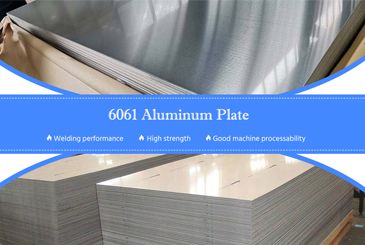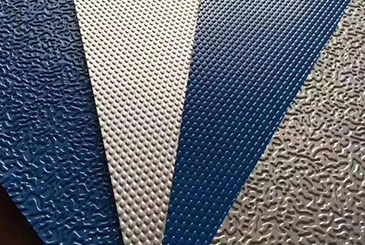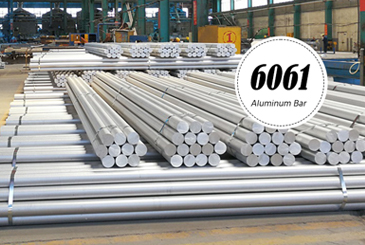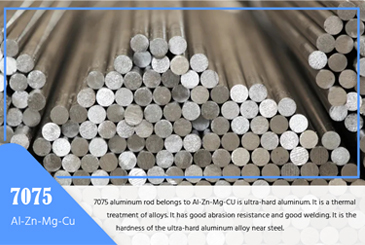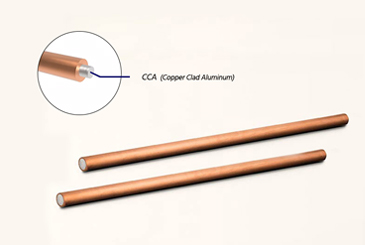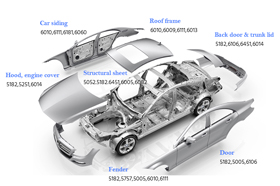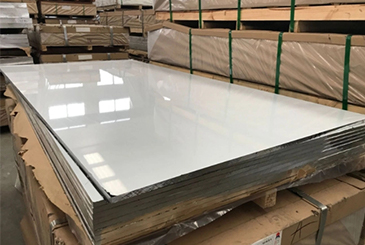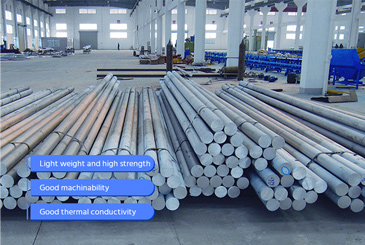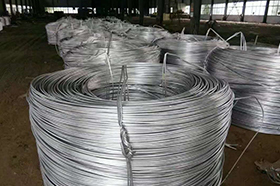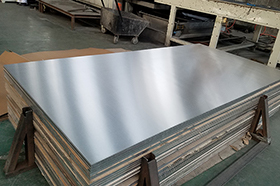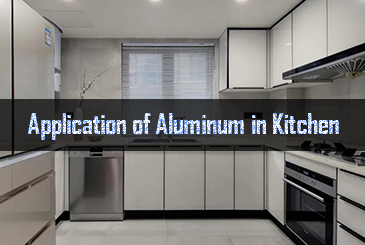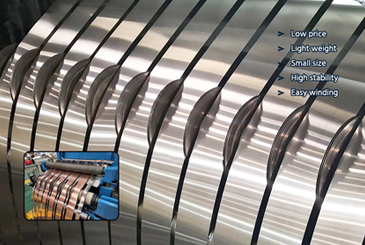Aluminum metal foam is a new type of structure-function integrated material.
Aluminum metal foam has the characteristics of both metal materials and porous materials. It has a series of excellent properties such as high porosity, low density, light weight, high strength, and good compressibility. It has light weight, sound insulation, sound absorption, noise reduction, flame retardant and other performance characteristics.
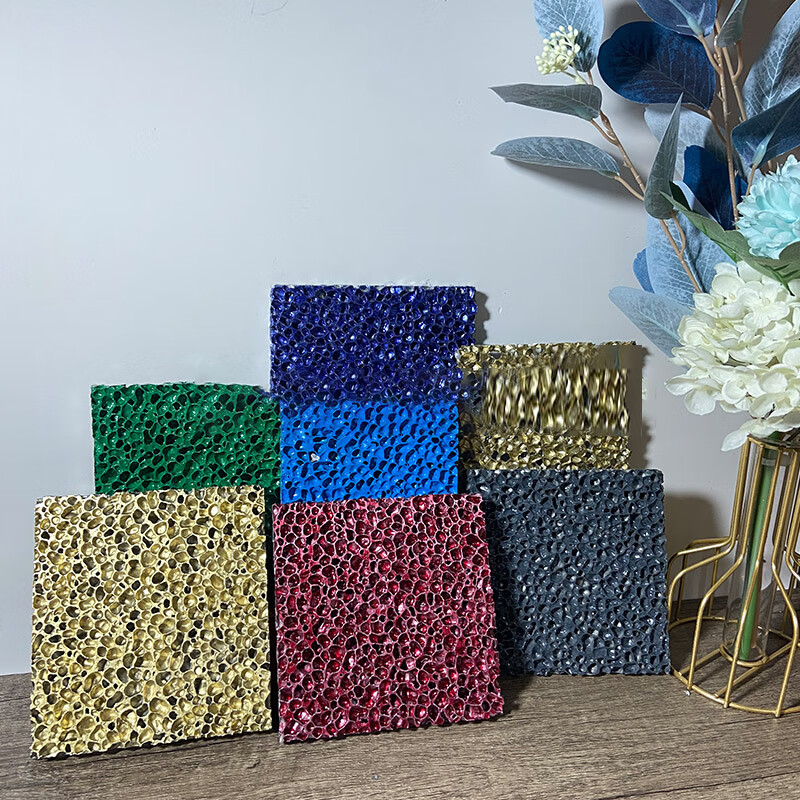
Density of porous aluminum foam
Density of porous aluminum foam depends on the volume percentage of metal and gas. Major feature affecting this material is the pore structure. Fluctuations in the pore structure can lead to density inhomogeneities. According to customer requirements, aluminum foam with different volume densities can be produced, which can reach 0.1-0.4 times of aluminum.
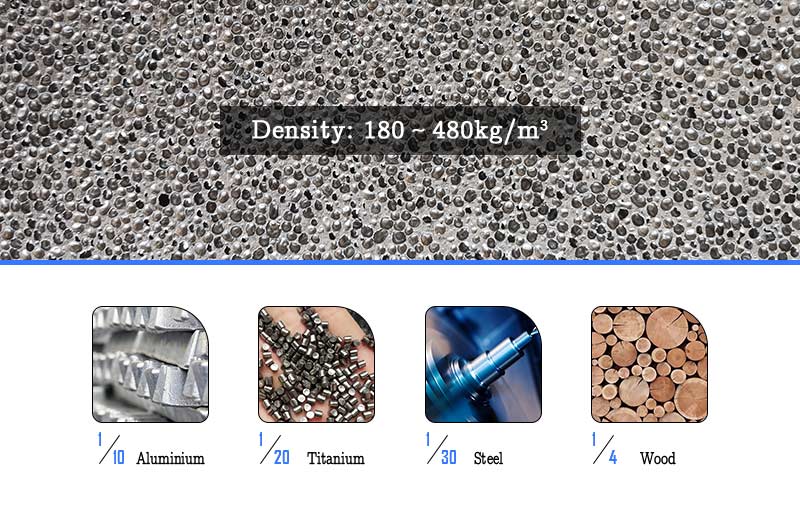
The density of porous aluminum foam varies to a large extent. The density is usually 180-480kg/m3, about 1/5-1/10 the density of aluminum, 1/20 the density of titanium, 1/30 the density of steel and 1/4 density of the wood. So it is a lightweight functional material.
The basic parameters of porous aluminum foam are pore size and porosity. The pore size is generally 0.5-5mm, and the porosity is usually 40%-90%.
Specifications of porous aluminum foam
Aluminum foam is divided into open-cell aluminum foam and closed-cell aluminum foam according to the type of cells.
The pores of open-cell aluminum foam are connected to each other, while the pores of closed-cell aluminum foam are independent and separated from each other. Therefore, aluminum foam can be regarded as a composite material of two phases of aluminum matrix and pores.
Aluminum foam has low thermal conductivity and does not burn. Among them, open cell aluminum foam has heat dissipation, and closed cell aluminum foam has heat insulation.
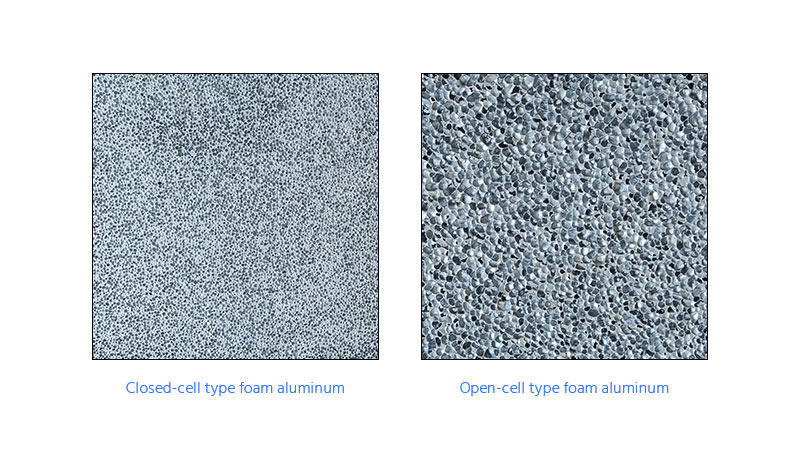
Open-cell aluminum foam
Open-cell foam aluminum panels are mainly used in halls, gymnasiums, concert halls and other buildings that require sound absorption, as well as the function of fluid filtration.
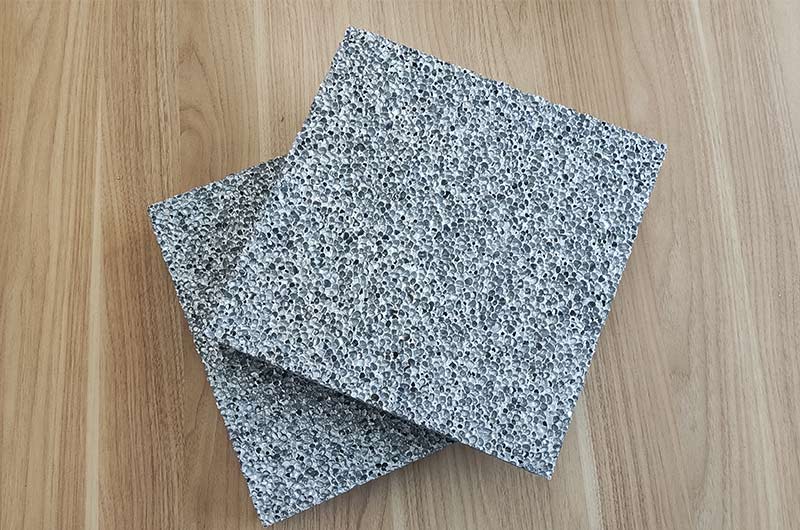
| Physical property | Open cell aluminum foam plate sheet |
| Bore diameter | 0.5~10mm |
| Voidage | 60%~70% |
| Open-cell rate | ≧92% |
| Density (G/CM3) | 0.25~1.05 |
| Electromagnetic shielding(DB) | 60~90 |
The electromagnetic frequency is between 2.6-18GHZ
| Damping energy absorption | Capacity absorption≥2.5MJ/CM3 |
| Bending strength (Mpa) | ≥27 |
| Compressive strength (Mpa) | >44 |
| Sound absorption coefficient (%) | 0.52~0.85 |
2000HZ, 20mm Thickness aluminum foam plate
| Sound insulation (DB) | 25~75 |
50-1050MHZ, 20MM Thickness aluminum foam plate
| Shock resistance | Good at absorbing shock and explosion energy from different directions |
| Thermal insulation performance | The coefficient of thermal conductivity is about 1/400 of pure aluminium. |
| Penetrability | Holes are interlinked, permeable and liquid permeable |
| Specific stiffness | Its bending stiffness is 1.5 times that of steel. |
According to the cell size, there are three types in open-cell aluminum foam
Large cell - open both sides and open one side
The shiny silver skin on both sides of this low density materials is removed to create a translucent panel. This panel is extremely lightweight and allows light to pass through. All chalco aluminum foam panels are highly reflective; however the bottom of this panel may be even more than others; sharply reflecting light and even picking up the colour of well lit material at a reflective angle to the panel.
The shiny silver skin of the large cell is removed and the cells underneath are exposed. This creates a surface that has been described as appearing like an "aluminum sponge". This is a low density material resulting in large, deep open cells.
Middle cell - open one or two sides
These middle cell aluminum foam panels are created by removing the surface on one side or both sides of the panel, through a special blasting process. The cells below the skin are exposed. This surface consists of a series of middle cell open areas and swirling solid areas, which mingle together to create an appearance described as similar to the surface of the moon or a frozen porous lava flow.
Small cell - -Open one or two sides
As per the middle open cell product, this small aluminum foam panel is created by removing the surface on one of the sides of the panel or both sides, through a special blasting process. Cells below the skin are exposed. This surface consists of a series of small open areas and swirling solid areas. They mingle together to create an appearance described as similar to the surface of the moon or a frozen porous lava flow.
Closed-cell aluminum foam
Closed-cell foam aluminum panels are mainly used in urban rail, highway sound barriers and other projects that require sound insulation. And other functions of energy absorption, shock absorption and anti-collision.
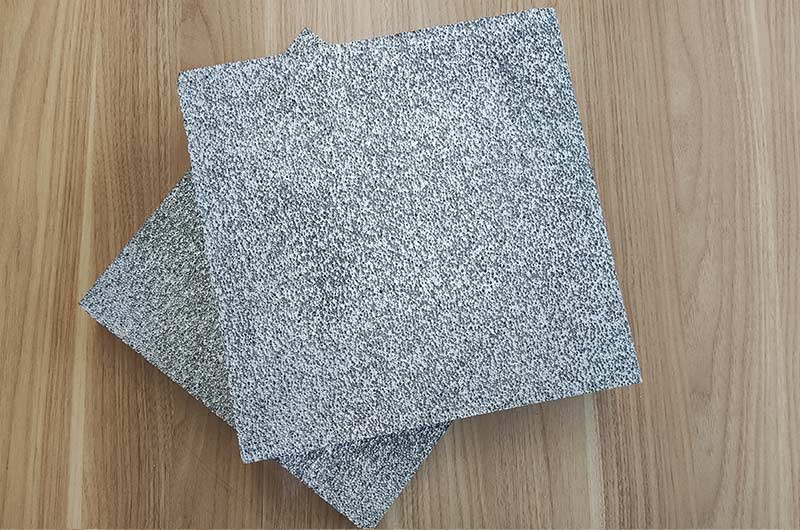
| Physical property | Close cell aluminum foam plate sheet |
| Bore diameter | 4~8mm |
| Voidage | 75%~90% |
| Open-cell rate | Close cell |
| Density (G/CM3) | 0.25~0.70 |
| Electromagnetic shielding(DB) | 60~90 |
The electromagnetic frequency is between 2.6-18GHZ
| Damping energy absorption | ≥2.5MJ/CM3 |
| Bending strength(Mpa) | 3~15 |
| Compressive strength (Mpa) | 3~17 |
| Sound absorption coefficient (%) | 40~80 |
2000HZ, 20mm Thickness aluminum foam plate
| Sound insulation (DB) | 20~40 |
50-1050MHZ, 20MM Thickness aluminum foam plate
| Shock resistance | Good at absorbing shock and explosion energy from different directions |
| Thermal insulation performance | The coefficient of thermal conductivity is about 1/400 of pure aluminium. |
| Specific stiffness | Its bending stiffness is 1.5 times that of steel. |
With the characteristics of noise reduction, heat insulation, strong impact resistance, electromagnetic shielding, and spherical interworking cavity with aesthetic characteristics, Chalco aluminum foam can be widely used in building insulation and insulation, swimming hall sound absorption wall, foam aluminum building curtain wall, sound insulation floor, entertainment places, and artistic buildings, hall, ceiling, wall decoration, etc.
Advantages of porous aluminum foam
Porous aluminum foam is a new type of light metal material produced by aluminum alloy foaming. It has low density and high strength. It has many excellent properties such as sound absorption and sound insulation, energy absorption buffer, flame retardant and explosion-proof, etc. It is widely used in cutting-edge industries such as military aerospace, rail transit, and shipbuilding. equipment field.
Aluminum foam has the following superior properties:
Lightweight, more than 50% weight reduction.
- The best energy-absorbing material, five times the energy-absorbing effect.
- The most excellent high-power electromagnetic shielding material.
- Bulletproof and explosion-proof, high performance, weight reduction.
- Flame retardant and heat insulation, the highest level of flame retardant.
- Sound-absorbing and sound-insulating, the only sound-absorbing material that is flame-retardant and resistant to moisture.
- Convenient construction. Foamed aluminum has good cutting performance, and can be easily cut with a saw. Aluminum foam can also be made into aluminum foam sandwich. It is a high-strength and very light board. It can be bonded with aluminum, copper, titanium and other thin plates on both sides of foamed aluminum to make a laminated board.
- Surface decoration effect is good. Coating has little damage to the sound-absorbing effect of foamed aluminum. With a special process, the surface of foamed aluminum can be painted with paint.
Production of porous aluminum foam
There are three common preparation methods for open-cell aluminum foam: sintering method, electroplating method, and casting infiltration method. The closed-cell aluminum alloy is more favored by the vehicle industry because of its better sound absorption, noise reduction, shock absorption, energy absorption performance, and excellent heat insulation performance. For the preparation of closed-cell aluminum foam, direct foaming method and air blowing method are more common.
Direct foaming method
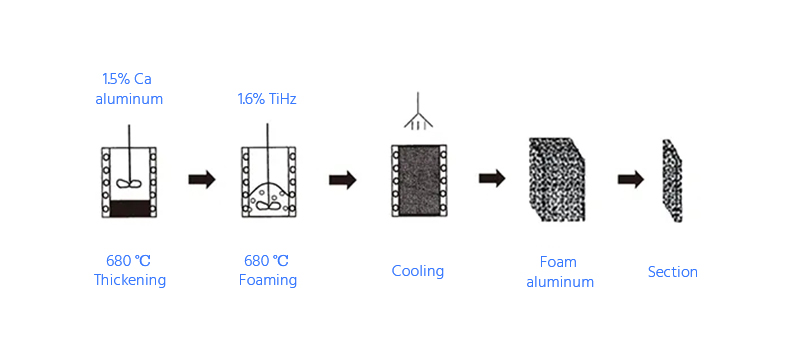
The direct foaming method used is mainly to add foaming agents such as TiH2, ZrH2, and CaH2 to the liquid aluminum alloy, and heat the foaming agent to decompose the bubbles to obtain spongy aluminum foam. This method is suitable for mass production, but the disadvantage is also obvious, because there is a density gradient in the vertical direction due to the influence of gravity. Using the most advanced slow-release technology can extend the overall hydrogen release time of TiH2 to about 180s. This can provide more operating time for the preparation process, and can make the air cells more uniform in size, so that the produced aluminum foam has a complete structure, stable performance, and low cost. Therefore, the main problem of direct foaming technology is a better and cheaper blowing agent.
Blow method
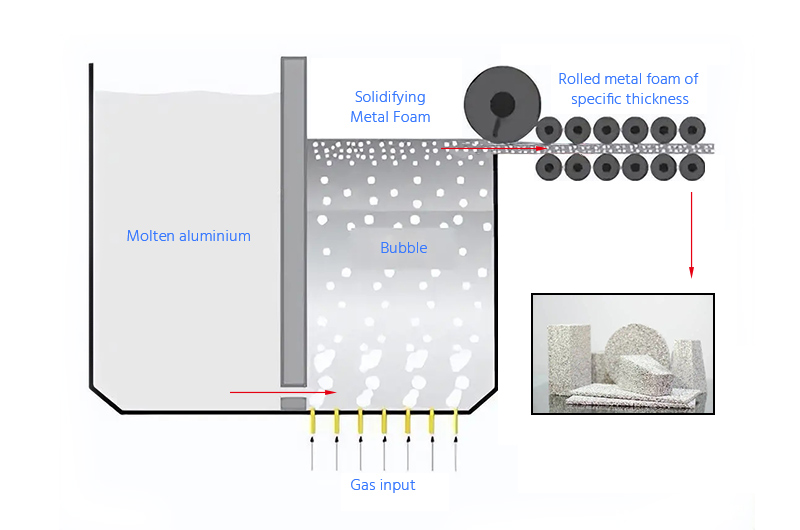
The blowing method is to blow gas (air, nitrogen, argon, etc.) into the molten aluminum block to prepare foamed aluminum. The key to the technology is that the molten aluminum should have a suitable viscosity. The biggest advantage of this method is low cost, but it is difficult to control the size and distribution of bubbles, and there is also an obvious density gradient in the direction of gravity, and at the same time, it consumes a lot of energy and pollutes. The blowing method is mainly used in the production of plates.
Powder metallurgy method
Powder metallurgy is an emerging technology. Aluminum foam is obtained by mixing aluminum powder or aluminum alloy powder with a foaming agent powder, then pressing it into a matrix, and then heating it to make the foaming agent act. Its biggest advantage is that it can control the size and distribution of bubbles, but the cost is high and the technology is not mature enough.
Hollow ball method
Aluminum alloy hollow microspheres were prepared by stir casting and pressure infiltration. Among them, the stirred casting method is suitable for preparing composite materials with a volume fraction of less than 30%, while the pressure infiltration method can prepare composite materials with a volume fraction of more than 60%. Hollow balls made by the hollow ball method are usually used as filling materials for composite materials. But the high cost makes this technology stop in the face of industrialization.
The properties of porous aluminum foam
Due to its extremely special porous structure, aluminum metal foam has very superior characteristics in terms of physical properties, mainly in physical properties, mechanical properties, damping properties, acoustic properties, thermal properties, fire resistance, electromagnetic shielding properties, etc.
Physical properties
The most obvious feature of porous aluminum plate is its light weight and low density, which changes with the change of pores, and its specific gravity is only 10%-40% of the same volume of aluminum.
Compared with solid aluminum materials, foamed aluminum materials have the characteristics of weak electrical conductivity, heat insulation and flame retardancy, high specific stiffness, high specific strength, good weather resistance and easy processing.
Mechanical properties
Porosity, pore size, pore structure and distribution are important parameters that determine the mechanical properties of porous metal foams. The tensile strength, yield stress, and elastic modulus of metal foams decrease exponentially with the increase of porosity.
Compared with solid aluminum materials, the elastic modulus, shear modulus, and elastic limit of foamed aluminum decrease exponentially with the increase of porosity. Therefore, its tensile strength is low, almost no elongation, and it is semi-brittle.
Relevant experiments have shown that the pore structure, shape and distribution of aluminum foam have a great influence on its tensile properties. When the relative density is the same, the tensile strength of aluminum foam with small pore size is higher than that of aluminum foam with large pore size.
Damping performance
When the aluminum foam is pressed to its yield point, the bubble diaphragm deforms. The aluminum foam has good cushioning and energy absorption effects. The continuous deformation of layers and the destruction of the bubbles show a good cushioning effect. In the process, it can produce a huge compression deformation, so as to absorb the impact energy. low thermal conductivity. Aluminum foam is only 1/60-1/500 of the thermal conductivity of pure aluminum, and the linear expansion coefficient is equivalent to that of pure aluminum.
Acoustic performance
The irregularity and three-dimensionality of the bubbles make it have many excellent characteristics. The foam is mainly composed of bubbles and aluminum diaphragms, and has excellent sound-absorbing properties.
The size of the aluminum foam pores affects its absorption performance for the entire frequency range of sound waves. The smaller the pores, the greater the sound absorption capacity.
Thermal properties
The metal matrix in the cross-section of the metal foam material accounts for a small proportion, most of which are gas channels, and the heat transfer capacity of these gas channels is very small. Therefore, the thermal conductivity of the closed-cell foam material is much smaller than that of solid materials.
The thermal conductivity of closed-cell aluminum foam is extremely low, only 1/51 - 1/500 of that of pure aluminum, which can be used as thermal insulation material.
The thermal conductivity of aluminum foam is closely related to the porosity, and the thermal conductivity decreases significantly with the increase of the porosity.
In addition, the heat-resistant temperature of aluminum foam far exceeds the melting point of pure aluminum, and aluminum foam will not produce toxic and harmful gases at high temperatures, so it can be used as a substitute for traditional heat insulation and heat-resistant materials.
Due to the large specific surface area of open-cell aluminum foam, heat can generate complex three-dimensional flow in the pores, so that it has excellent heat dissipation capability. In addition, the softening temperature of aluminum foam exceeds 500 °C, so it has good heat resistance and flame retardancy.
Fire resistance
Aluminum with foam has good fire resistance, and the melting point of aluminum is 660°C. Since it cannot bear its own weight, it begins to soften, but it does not melt. When there is no external force constraint, aluminum foam will maintain its original shape even at a high temperature of 780°C, which shows that compared with ordinary sound-absorbing materials, aluminum foam can withstand higher temperatures.
Moreover, aluminum foam is a non-combustible material, so there is no need to worry about it producing harmful gases.
The large specific surface of aluminum foam greatly increases the contact area between the fluid and the surface of the material. Aluminum foam has excellent surface exchange ability. Aluminum foam is the carrier of huge surface chemical reactions, and it is also a good material for manufacturing heaters and heat exchangers. Using the large specific surface area of aluminum foam, high material and energy exchanges can be achieved when fluids pass through.
Electromagnetic shielding performance
Aluminum foam has electromagnetic shielding properties. Due to the interconnection of the aluminum foam skeleton, it has a huge specific surface area and a good ability to absorb and reflect electromagnetic waves. Various losses will occur in the aluminum foam matrix for electromagnetic waves, such as absorption loss, reflection loss, and catastrophe loss. Among them, reflection loss accounts for dominant, so that aluminum foam has excellent electromagnetic shielding performance.
Application of Porous Aluminum Foam
Aluminum foam has various excellent properties. Therefore, it is often used as shock absorption and noise reduction materials, electromagnetic wave shielding materials, flame retardant and heat exchange materials and filter materials in the fields of automotive equipment, aerospace, construction industry and environmental protection. It has very good application prospects.
Automotive industry
With the development of modern automobile technology, automobile manufacturing materials require high strength and light weight. Due to the excellent performance of aluminum foam, it can be widely used in many parts of automobile manufacturing, mainly for shock resistance of the car body and noise reduction and vibration isolation of the car body, such as engine compartment cover, luggage compartment cover, fender, bumper, Muffler, etc.
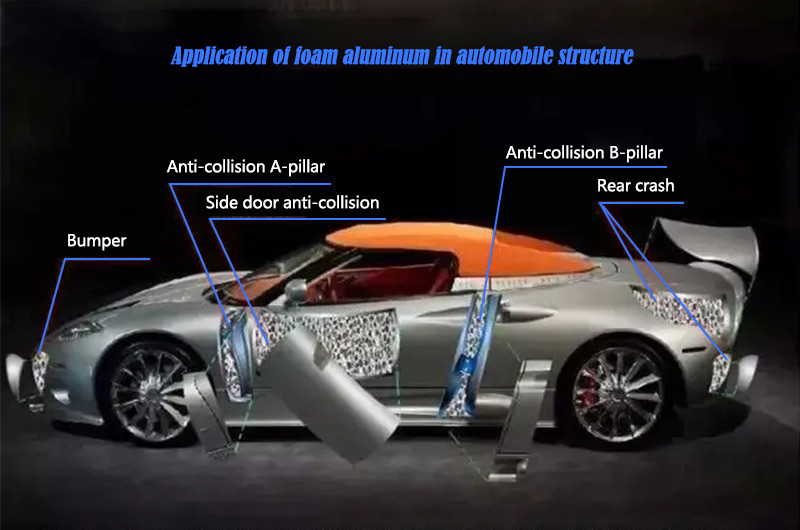
Aluminum foam plays an important role in the research and development of lightweight, and aluminum foam can absorb sound, reduce noise, shock absorption, and absorb energy, so aluminum foam is widely used in automobile bumpers, longitudinal beams, pillars and other components.
Aluminum foam sandwich is used as the roof material, which not only reduces the mass by half compared to the original steel material, but also increases the rigidity by 10 times, and the thermal insulation performance is 20 times higher than that of normal aluminum. It has a strong ability to eliminate noise with a frequency greater than 800 Hz.. The roof cover is made of sandwich composite foam aluminum.
Aluminum foam is also installed between the impact-resistant beams and bumpers because of its good shock-absorbing properties.
Aerospace
The basic requirements for aircraft design in the aerospace field are light weight and high strength.
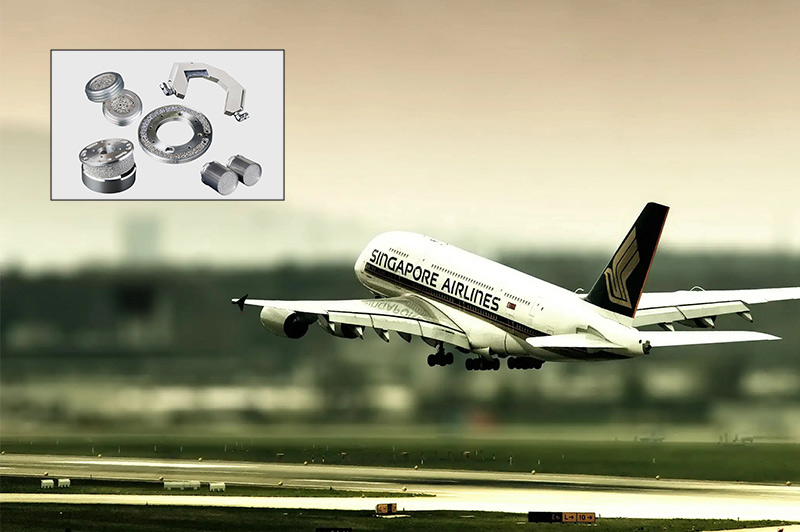
As a substitute for aluminum honeycomb structure, aluminum foam has the characteristics of light weight, high specific strength, excellent damping characteristics, and low production cost. It meets the requirements of material performance in the aerospace field and is an ideal functional and structural material for aerospace engineering. It has a very broad application prospect.
At present, aluminum foam is mainly used in the buffer protection structure, environmental control system and thermal control system of manned spacecraft.
The aluminum foam sandwich structure is used to manufacture spacecraft buffers, shock absorbers and the bottom of the spacecraft return cabin, so that the spacecraft can achieve a soft landing and protect astronauts and aerospace equipment. Through effective energy absorption and shock absorption, aluminum foam can also ensure the safety of astronauts and spacecraft under extreme instantaneous impact loads.
In addition, aluminum foam is also used in various parts of the aircraft, such as the protection of landing gear, elevators and transmitters, ship partitions, bulkheads, aircraft parts, elevators, lifts, pallets, workbenches, etc.
Construction industry
Lightweight, high strength, and flame retardant structural materials are required in many building facilities. Due to its light weight, high temperature resistance, non-flammability and other physical properties, aluminum foam can be used as a substitute for many existing building materials. The heat insulation and flame retardant properties of foamed aluminum can effectively prevent fires, and can be used as fire doors and fire compartments.

Aluminum foam board is used for the decoration of indoor ceilings and partition walls. It is not only light and beautiful, but also has the effects of fire prevention, sound insulation, noise reduction, and heat insulation.
In public places such as gymnasiums, swimming pools, concert halls, conference halls, entertainment halls, station wharves and other public places, aluminum foam materials are used for decoration, which can effectively avoid sound resonance and reverberation.
The application of aluminum foam board in the elevator cabin can reduce power consumption and reduce noise.
In short, foamed aluminum is widely used in the construction industry for its characteristics of sound absorption, heat insulation, flame retardancy, and light weight.
Electronic communications
When the aluminum foam is pressed to its yield point, the bubble diaphragm deforms. The aluminum foam has good cushioning and energy absorption effects. The continuous deformation of layers and the destruction of the bubbles show a good cushioning effect. In the process, it can produce a huge compression deformation, so as to absorb the impact energy.
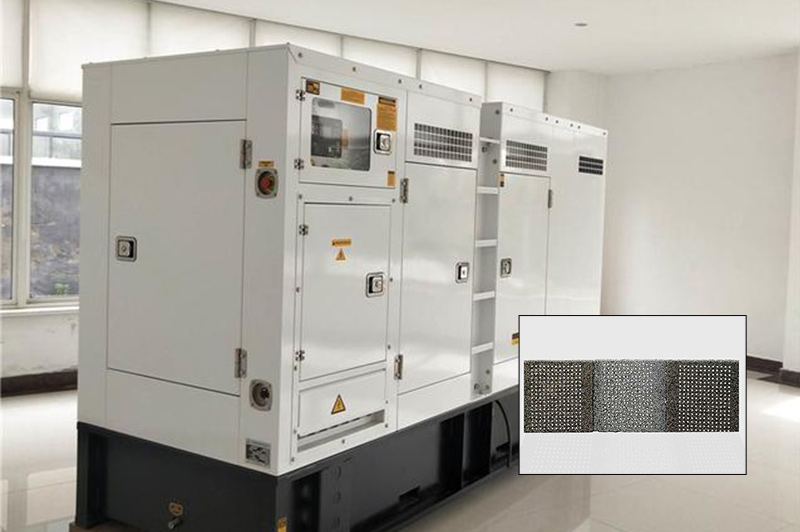
Porous aluminum plate is most suitable for making ceilings and walls of electrical equipment rooms. Aluminum foam has excellent electromagnetic shielding properties and can also be used as electromagnetic shielding materials. It also has sound-absorbing properties. So it is an ideal material.
Aluminum foam is also used in structural and functional materials for electromagnetic shielding, electronic and electrical housings, generator rooms, radio recordings, etc.
Environmental protection
Aluminum foam sheet is a kind of sound-reducing and noise-reducing material for highways and residential areas. It has been widely used in guardrails, billboards, packaging materials, various plastic products, pipes, audio equipment, tennis court floors, fire-resistant and sound-proof products, heat exchangers, filters, etc.
Military industry
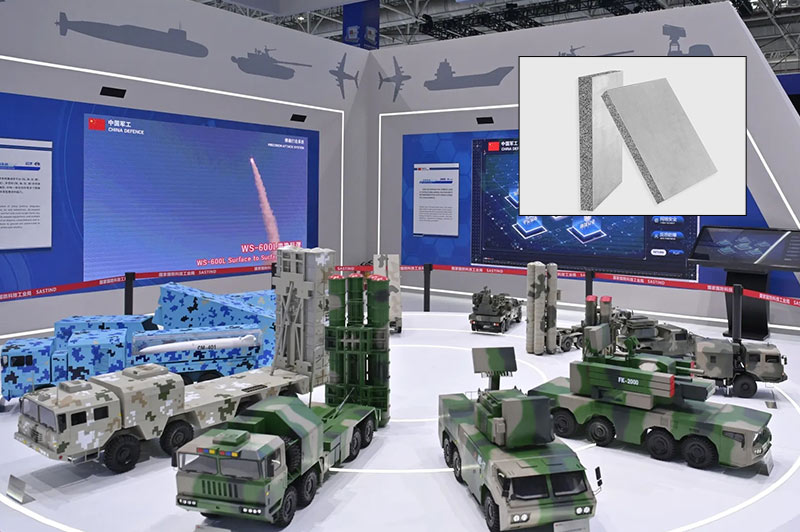
Aluminum foam is a porous material that combines light weight, high specific rigidity, high specific strength, strong impact absorption capacity, vibration reduction, sound insulation and noise reduction, etc. Using aluminum foam panels as the core material and dense metal as the cover plate to design and manufacture the armored vehicle floor will improve the vehicle's light weight, blast resistance, sound insulation and noise reduction, and thus enhance the combat effectiveness of the armored vehicle.
The application in the weapon manufacturing industry utilizes the characteristics of light weight, high strength, excellent elasticity and energy absorption and shock absorption of foamed aluminum composite materials. It is used to produce light, high mobility and transportable explosion-proof armor systems, and to make military airdrop packaging boxes.
Utilizing the characteristics of foam aluminum for noise reduction and noise reduction, it is used to manufacture silent submarines and guided missile destroyers for noise reduction and noise reduction.
Using the electromagnetic shielding performance of foamed aluminum, it is used for the lining of command vehicles, command posts and field barracks to prevent information leakage.
Aluminum foam also has the effect of shock absorption. It is installed outside the power unit of the torpedo, which can reduce the sound generated by part of the mechanical vibration and friction. In addition, aluminum foam also has excellent fire resistance, it will not burn or lose its integrity at around 1000 °C, which greatly enhances the safety of torpedoes. It can be seen that the characteristics of aluminum foam give it a broad prospect in the application of torpedoes.
In the battlefield environment, ammunition strike is the main threat to the safety of ground personnel and equipment. Conventional ammunition mainly relies on the damage element generated by the warhead to carry out strike damage. Common damage elements include fragments and shock waves. The use of protective materials to make protective packaging or construct protective barriers is an important measure for ammunition damage protection. Aluminum foam is widely used in the field of explosion protection because of its excellent energy-absorbing properties. It is usually combined with metal, ceramics, fibers and other materials in a layered stacking and void filling manner to form a composite material. "Metal panel + aluminum foam core layer + metal" - the aluminum foam sandwich panel of the back panel is a typical aluminum foam composite material.
Rail
The train generates vibration and noise during operation, which not only affects the comfort of the car, but also shortens the service life of car body parts. Aluminum foam is used instead of traditional materials to make train floors and side linings to achieve the purpose of shock absorption and noise reduction.
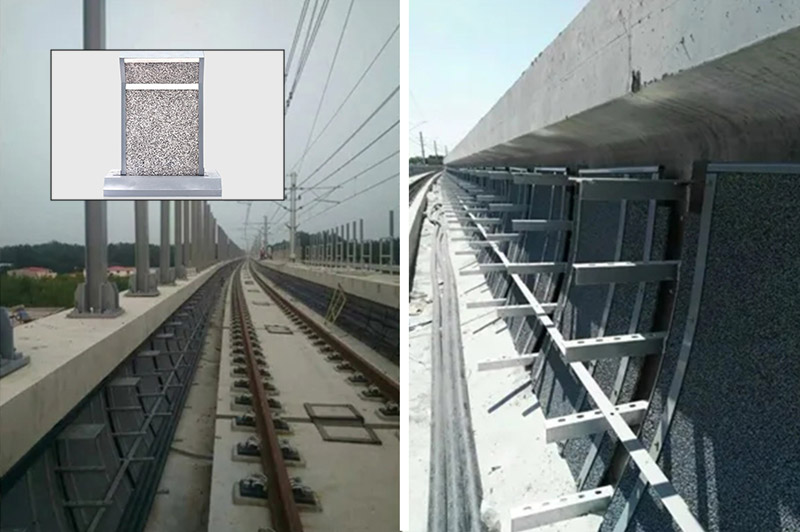
The low density, high rigidity, sound insulation performance, heat insulation performance, fire resistance performance, energy absorption performance and non-toxic gas release of foamed aluminum are widely used in the rail transit industry. It is also used in various carriages and containers.
It has good sound insulation and noise reduction functions, and the foamed aluminum material also has good heat insulation and radiation shielding capabilities. While the bridge sound barrier absorbs noise pollution, it can effectively block heat transfer and engine radiation from vehicles.
Chemical industry
Aluminum foam has excellent permeability and is a good filter material that can be used to filter out solid particles from petroleum, gasoline, refrigerants, polymer melts, suspensions, air and other air streams, and can also be used as separation medium.
Open-cell aluminum foam has good heat exchange performance, and the use of this foam metal can enhance the heat exchange capacity of equipment such as condensing towers for air cooling.
Marine industry
Aluminum foam has good sound absorption performance, and has the characteristics of fire resistance, flame retardancy, moisture resistance, and no dust. It solves the problems that traditional sound absorption materials are easy to absorb moisture and endanger the health of crew members. It is more suitable as a noise reduction material for ship cabins.
The simulation results of ship cabins show that the cabin noise can be reduced by an average of about 10dB after the installation of foam aluminum noise reduction materials, and the noise reduction effect is remarkable. After the sound-absorbing surface is installed, the high-frequency noise is effectively controlled, and the noise-reducing effect fluctuates greatly in the low- and intermediate-frequency (≤1000Hz) bands, and the degree of reduction is relatively small.
Bridge protection
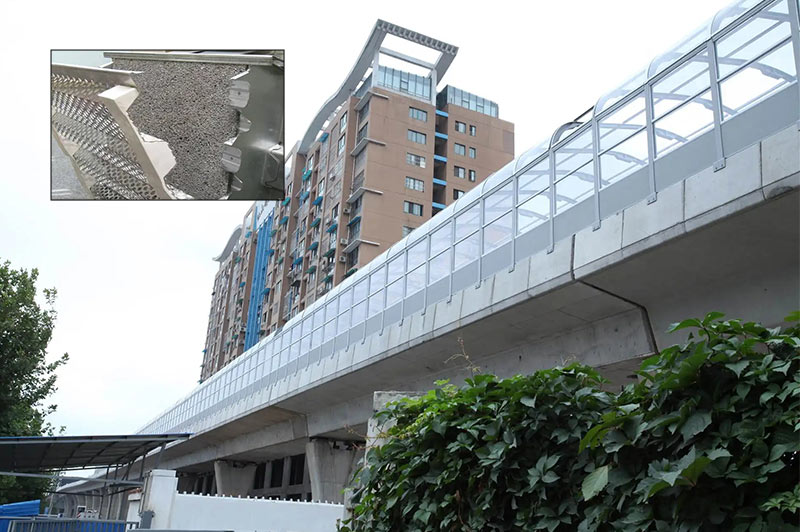
Stabilized aluminum foam is a new structural and functional material with both metal and foam properties, which is made by adding additives to pure aluminum or aluminum alloy for foaming. When subjected to impact loads, aluminum foam can absorb a large amount of energy at a lower stress level. Therefore, the aluminum foam anti-collision device has the characteristics of light weight and good energy absorption, and has broad application prospects in the protection of bridge piers.
The composite anti-collision structure of foamed aluminum-based pier is a composite energy-dissipating protective structure composed of outer steel plates, inner steel plates, stiffeners, outer layers filled with high-density foamed aluminum, and inner layers filled with low-density foamed aluminum.
Chalco Aluminum - the best porous aluminum foam supplier
As an excellent new material, aluminum foam usually has excellent mechanical properties, chemical properties and physical properties, as well as recyclability. It has broad application prospects due to its stable performance and suitable for large-scale commercial production, including sound absorption, energy absorption, sound insulation, heat dissipation, flame retardancy, vibration reduction, electromagnetic shielding and good damping properties. With the development of society, the application value of aluminum foam will become more and more prominent.
Chalco Aluminum, your best aluminum foam solution provider.


